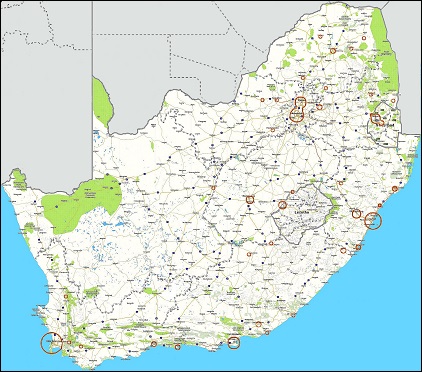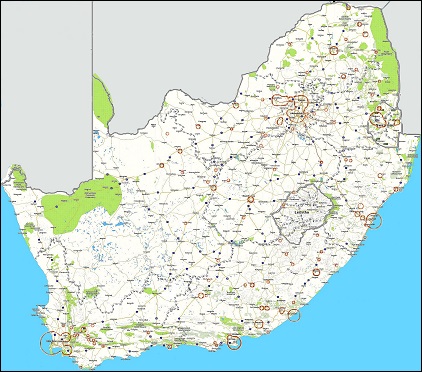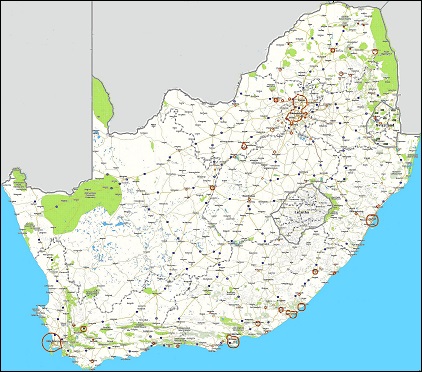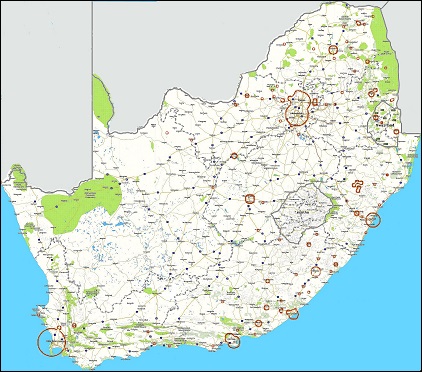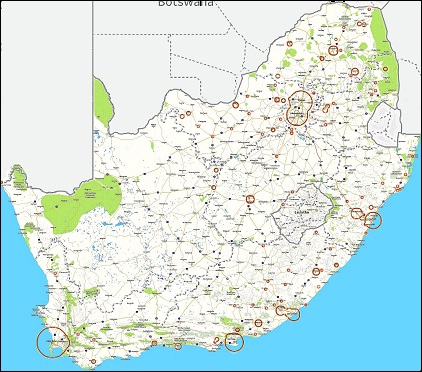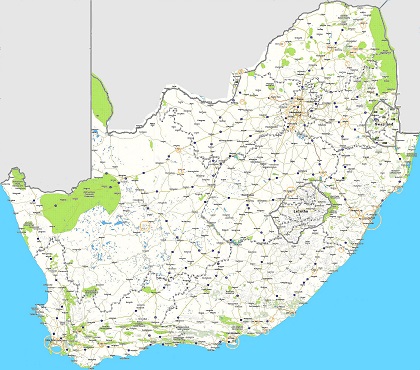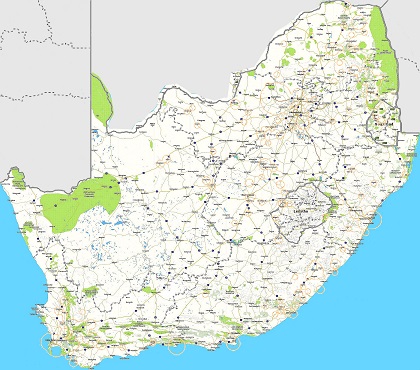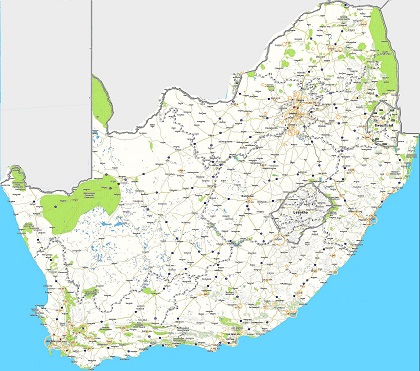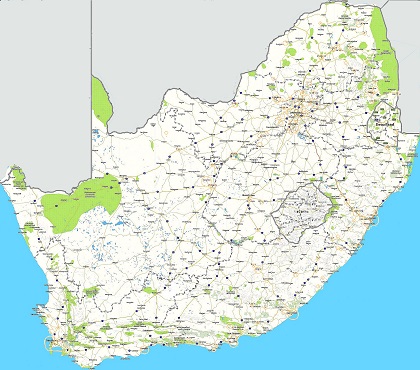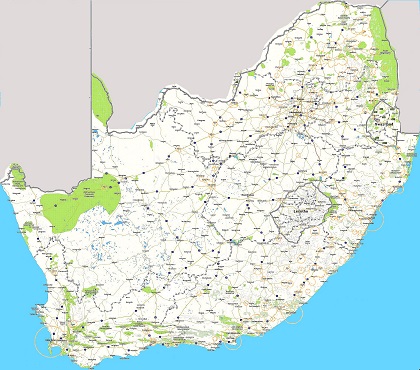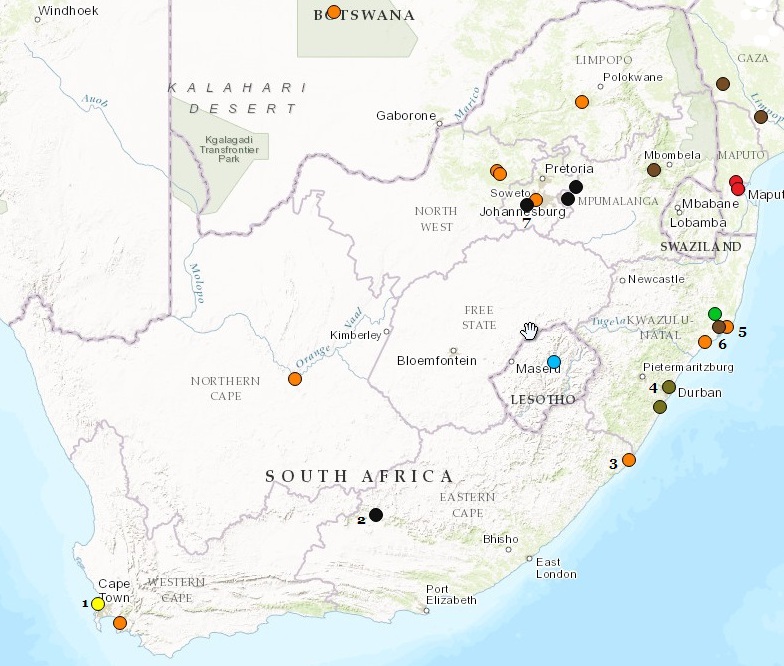BRICS FROM BELOW |
||
| HOME NEWS RESERCH SOLIDARITY MAPPING | ||
| PROTEST MAPPING | BRAZIL CHINA INDIA RUSSIA SOUTH AFRICA BRICS IN AFRICA | |
|
FILTER BY Keyword |
||
| |
PROTESTS IN SOUTH AFRICASouth Africa has been dubbed "the protest capital of the world", with one of the highest rates of public protests in the world.It is often argued that the rate of protests has been escalating since 2004, However Steven Friedman argues that the current wave of protests stretches back to the 1970s. The rate of protests "rose dramatically in the first eight months of 2012" and it was reported that there 540 protests in the province of Gauteng between 1 April and 10 May 2013 In February 2014 it was reported that there had been "nearly 3,000 protest actions in the last 90 days – more than 30 a day– involving more than a million people". Since 2008 more than 2 million people have taken to the streets in protest every year. Njabulo Ndebele argues that "Widespread 'service delivery protests' may soon take on an organisational character that will start off as discrete formations and then coalesce into a full-blown movement". There has been considerable repression of popular protests. The most common reasons for protests are grievances around urban land and housing. It has been reported that "Nearly 75% of South Africans aged 20-29 did not vote in the 2011 [local government] elections" and that "South Africans in that age group were more likely to have taken part in violent street protests against the local ANC than to have voted for the ruling party". In September 2013 the police reported that they had "made more than 14,000 arrests at protests in the past four years". According to The Times "Informal settlements have been at the forefront of service delivery protests as residents demand houses and basic services". MAJOR PROTESTS 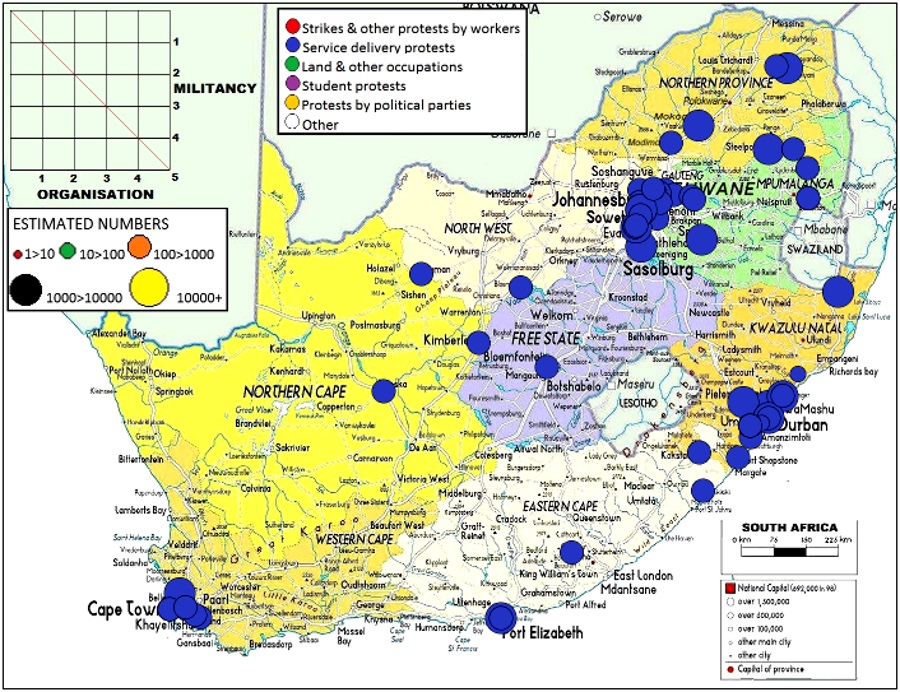 "Service Delivery" protests 2016
STRIKES AND OTHER LABOR RELATED PROTESTS 2011 - MARCH 2016 MAJOR PROTEST CAMPAIGNS
2012 MARIKANA STRIKE The Marikana massacre,which took place between 10 August and 20 September 2012, was the single most lethal use of force by South African security forces against civilians since 1960. The shootings have been described as a massacre in the South African media and have been compared to the Sharpeville massacre in 1960. The incident also took place on the 25-year anniversary of a nationwide South African miners' strike. 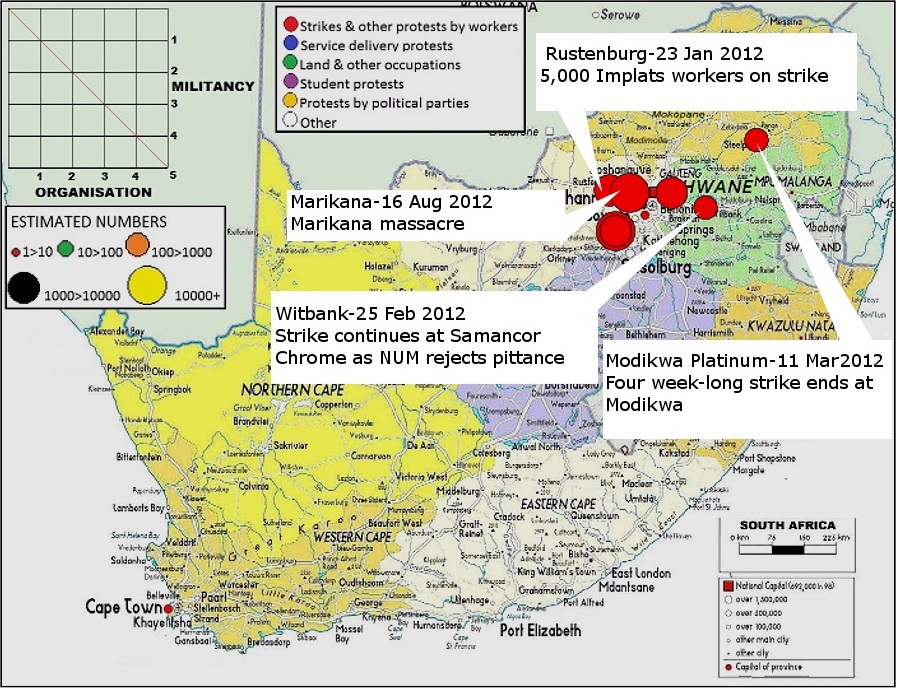 Strikes in the mining sector 2012 Controversy emerged after it was discovered that most of the victims were shot in the back, and many victims were shot far from police lines. On 18 September, a mediator announced a resolution to the conflict, stating the striking miners had accepted a 22% pay rise, a one-off payment of 2,000 rand and would return to work 20 September. The strike is considered a seminal event in modern South African history, and was followed by similar strikes at other mines across South Africa, events which collectively made 2012 the most protest-filled year in the country since the end of apartheid. On 10 August 2012, rock drillers initiated a wildcat strike in pursuit of a pay raise to 12,500 South African rand per month, a figure which amounted to tripling of their monthly salaries (from approx. US$500 to $1,500). The strike occurred against a backdrop of antagonism and violence between the African National Congress-allied National Union of Mineworkers (NUM) and its emerging rival, the Association of Mineworkers and Construction Union (AMCU). According to a Guardian columnist, the NUM was closely linked to the ruling ANC party but lost its organisational rights at the mine after its membership dropped from 66% to 49% and its leadership began to be seen as 'too close' to management. Prior peaceful protests and fatal clashes. At the Marikana platinum mine, operated by Lonmin at Nkaneng near Rustenburg, 3,000 workers walked off the job on 10 August after Lonmin failed to meet with workers. On 11 August, NUM leaders allegedly opened fire on striking NUM members who were marching to their offices.The killing of two miners was reported in the South African media as a central reason for the breakdown in trust within the union amongst workers. Despite earlier contradictory reports, the clashes on the 11th are now acknowledged to be the first incidents of violence during the strike. Between 12 and 14 August, approximately nine people were killed in the area around Marikana. There are conflicting reports on who killed whom during these dates. However, at least four miners, two police officers, and two security guards seem to have been killed during this time. During the Farlam Commission, the advocate for AMCU accused Lonmin of conspiring with police in killing two miners during a march back from Lonmin offices on 13 August, after which two police officers were also killed. Before the shootings, SAPS Captain Dennis Adriao told journalists: "We have tried over a number of days to negotiate with the leaders and with the gathering here at the mine, our objective is to get the people to surrender their weapons and to disperse peacefully." However, submissions to the Farlam Commission dispute this, accusing police of failing to negotiate with strikers and participating in revenge killings. The Association of Mineworkers and Construction Union's Joseph Matunjwa said that the protests were in response to poor pay: "As long as bosses and senior management are getting fat cheques, that's good for them. And these workers are subjected to poverty for life. [After] 18 years of democracy, the mineworker is still earning 3,000 [South African Rand – approximately $360] under those harsh conditions underground." 16 August massacre On the afternoon of 16 August, members of a contingent of the South African Police Service, from an elite special unit, opened fire with assault rifles (R5 rifles), on a group of strikers. Within minutes 34 miners were killed, and at least 78 were wounded. The incident was the single most lethal use of force by South African security forces against civilians since the Sharpeville massacre during the apartheid era. There was a small protest outside parliament in Cape Town the day after the shootings. Two other mines also had similar protests, after the shooting, demanding a 300% salary increase. Police were present at the sites in case there was violence and to prevent an escalation of strikes. North West Province Premier Thandi Modise warned of spreading protests if the growing inequality gap was not dealt with. The same day Jacob Zuma visited the Marikana mine. On 4 September, the Gold Fields mine outside Johannesburg also had protests by mine workers. Neal Froneman, the C.E.O. of Gold One International who runs the mine, said that police were called to disperse the protesters. As a result of clashes that involved the stoning of a vehicle carrying others to work and tear gas and the firing of rubber bullets four people were injured. Froneman said: "Our security had to intervene, they used rubber bullets and police used rubber bullets and tear gas. Four people were slightly wounded and all have been released from the hospital." However, Pinky Tsinyane, a police spokesman, said that one of the injured workers was in critical condition; he added that four others had been arrested for public violence. The company spokesman, Sven Lunsche, further noted that about 12,000 of Gold Fields' workers "continue to engage in an unlawful and unprotected strike" that began on 28 August and, according to him, was the result of an internal dispute between the local union leaders and members of the National Union of Mineworkers.[65] As the solidarity protests spread to other mines, Julius Malema addressed a rally at the KDC Gold Fields mine, where a majority of the 15,000 workers were on strike. He said: "The strike at Marikana must go into all the mines. R12,500 is a reality. They must know, the mine bosses, that if they don't meet your demand, we're going to strike every month for five days, demanding R12,500." As the body of a man hacked to death was found on the same day at the Marikana mine, Malema also called for a nationwide miners' strike. On 16 September, about 1,000 miners in Rustenburg organised a solidarity march for the Marikana miners who marched the previous day. However, while this group was applying for a permit to demonstrate against police brutality the previous day, police helicopters encircled them in what was seen as intimidating leading to the miners dispersing. On 19 September, the same day as the announcement of a resolution to the Marikana strike, workers at Anglo American Platinum staged a strike demanding a similar offer at its Rustenberg mine. Mametlwe Sebei, a community representative, said in response to protests that at the mine "the mood here is upbeat, very celebratory. Victory is in sight. The workers are celebrating Lonmin as a victory." The strikers carried traditional weapons such as spears and machetes, before being dispersed by police using tear gas, stun grenades and rubber bullets against the "illegal gathering", according to police spokesman Dennis Adriao. Central Methodist Church Bishop Paul Verry said that one women who was struck by a bullet died. At the same time, an unnamed organiser for the Association of Mineworkers and Construction Union of protests at Impala Platinum said: "We want management to meet us as well now. We want 9,000 rand a month as a basic wage instead of the roughly 5,000 rand we are getting." Anglo Platinum then said in a statement that: "Anglo American Platinum has communicated to its employees the requirement to return to work by the night shift on Thursday 20 September, failing which legal avenues will be pursued." A wave of strikes occurred across the South African mining sector. As of early October analysts estimated that approximately 75,000 miners were on strike from various gold and platinum mines and companies across South Africa, most of them illegally.[15] Citing failure of workers to attend disciplinary hearings, on 5 October 2012, Anglo American Platinum—the world's biggest platinum producer—announced that it would fire 12,000 people. It said it would do so after losing 39,000 ounces in output – or 700 million rand ($82.3 million; £51 million) in revenue. The ANC Youth League expressed anger at the company and pledged solidarity with those who had been fired: https://en.wikipedia.org/wiki/Marikana_killings 2014 SOUTH AFRICAN PLATINUM STRIKE On January 23, 2014, nearly 70,000 AMCU platinum workers in the Rustenburg area went on strike. The strike affected all three of South Africa's major platinum producers, with Lonmin hardest hit. Roughly 40% of the world's platinum production was shut down as a result. AMCU demanded that minimum wage be increased from 5,000 rand ($US480) to 12,500 rand ($1,200) a month. The platinum companies called the demand unrealistic and for most of the strike refused to go beyond a 10% wage increase. One estimate suggested platinum would have to hit $2,405 an ounce for the industry to break even if the workers demands were met; platinum sold for roughly $1,430 an ounce when the strike started. By June, AMCU was arguing for steady wage increases over 4 years to meet the 12,500 rand goal by 2017 instead of immediately. In May, Ngoako Ramatlhodi was appointed as the new Minister of Mineral Resources. He immediately appointed a task force to try to restart stalled negotiations. On June 7, Ramatlhodi said he would pull out of negotiations if a deal was not reached by the 9th. However, he denied he was "abandoning" negotiations. I strongly believe we've done enough work ... for the parties to be able to move forward [independently]," he said. On June 12, a preliminary agreement was reached when the mining companies offered a 1,000 rand per month pay increase. The offer was quickly endorsed by some workers and AMCU leader Joseph Mathunjwa publicly stated a deal was imminent the following day. However, other workers raised concerns about the length of the agreement, back pay, and living allowances. The union then made additional demands, stalling talks. On June 18, it was revealed that AMCU was demanding a one-time 3,000 rand payment for every worker to compensate for the strike and that workers fired during the strike be rehired. The union also requested the platinum companies not pursue criminal charges against workers suspected of violence during the strike. In exchange, they promised to avoid future strikes. In a joint statement, the platinum companies said the new demands would cost an additional 1 billion rand and were impossible to meet. https://en.wikipedia.org/wiki/2014_South_African_platinum_strike WESTERN CAPE 2012 FARM WORKERS STRIKE The Western Cape 2012 Farm Workers' strike was a wave of strikes and protests by agricultural workers in the Western Cape from 27 August 2012 to the 22 January 2013. The events led the deaths of 3 workers, R160 million in damages as well as a 52% increase in the official minimum wage. The protests mostly took place the towns of De Doorns and Worcester with smaller protests in Ceres, Robertson, Grabouw, Wolseley and Villiersdorp. The main cause of the strikes was low worker pay of R69 (roughly US$8.54 in 2012) per day and high unemployment. On 14 November COSATU announced that the strike was suspended but workers continued with their strike. The next day, most farmworkers remained on strike. This led to a split between the Food and Allied Workers Union (FAWU), which is affiliated with COSATU, and the leadership of COSATU in the Western Cape with the former opting to support the farmworkers in defying COSATU's agreement with government. According to the Daily Maverick, Cosatu did not have a democratic mandate to call off the strike on 4 December 2010. The strike was resumed in January 2013. It was, again, accompanied by considerable violence by and spreading to the towns of Villiersdrop and Wolseley. It was argued[by whom?] that Nosey Pieterse, the president of the Black Association of the Wine and Spirit Industry and general secretary of Bawusa, the Bawsi Agricultural Workers Union of South Africa, emerged as the primary leader in the strike in January 2013. However others have argued that the strike was largely self organised and that leaders were largely self-proclaimed. Letsekang Tokhwane, 25, was shot dead by the police on 14 January 2013. The strike was finally called off on 22 January 2013. A number of workers were fired as a result of their participation in the strike. The strikes had an imitate impact on the daily minimum wage for agricultural workers being raised from R69 (roughly US$8.54 in 2012) per day to R105 (US$13 in 2012) per day. The event was also used as a regional campaign issue in the run up to the South African general election of 2014. Attempts to resume the strike one year later in November 2013 where unsuccessful due to a reported lack of interest by workers and well as disagreement over the necessity of striking again. The Western Cape's premier and member of the Democratic Alliance (DA), Helen Zille, stated that she believed there was a political motive for the strike with the African National Congress stoking unrest in the province to present the DA run province as "exploitative, racist and ungovernable". https://en.wikipedia.org/wiki/Western_Cape_2012_Farm_Workers%27_strike FEES MUST FALL #FeesMustFall is a student led protest movement that began in mid October 2015 in response to an increase in fees at South African universities. Protests started at the University of Witwatersrand and spread to the University of Cape Town and Rhodes University before rapidly spreading to other universities across the country. The 2015 protest ended when it was announced by the South African government that there would be no tuition fee increases for 2016. The protest in 2016 began when the South African Minister of Higher Education announced that there would be fee increases capped at 8% for 2017; however, each institution was given the freedom to decide by how much their tuition would increase. By October 2016 the Department of Education estimated that the total cost in property damage due to the protest since 2015 had amounted to R600 million (equivalent to US$44.25 million). 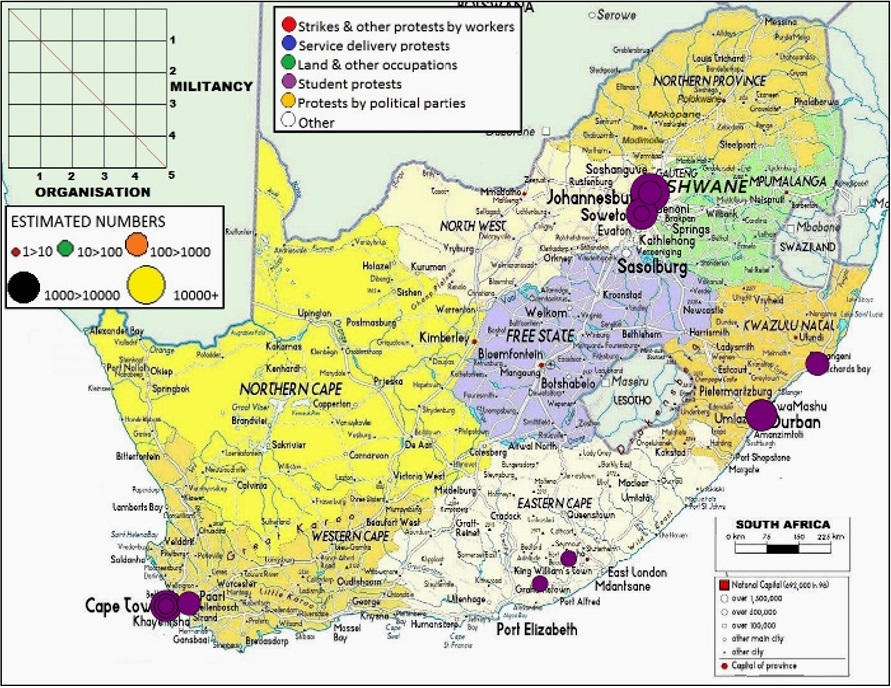 Student protests 2015 12–19 October: Students at the University of Witwatersrand started protesting on 14 October 2015 in response to an announcement by the university that fees would be raised by 10.5%. This led to a sit in and lock down of the university by students and some staff that, on 17 October, resulted in the university agreeing to suspend the fee increase and renegotiate it as well as not seek disciplinary action against participating students or staff members. On Sunday 18 October messages started circulating on Facebook about a possible complete shut down of the Rhodes University campus. 19 October: By Monday 19 October fresh negotiations between students and the university had begun. On the same day similar protests had spread to the University of Cape Town and Rhodes University. On the same day management at the University of Cape Town -which had announced a 10.3% fee increase the week before- applied for and received a court interdict to prevent protests at the university. Students started blocking vehicle access by placing rocks, dustbins, and benches on the roads leading into the campus. Students went ahead and led by the Rhodes Must Fall movement occupied the university's administration building. Riot police were called to forcibly evict the protesters with over 25 students being arrested late at night. Reportedly over a thousand students then gathered at the Rondebosch police station and held an all night vigil calling for the student's release. At Rhodes University students reportedly started barricading themselves into the university and forcibly turning away others from entering the campus. Students at the University of Pretoria reportedly initiated plans to lock down three of that university's campuses for Wednesday 21 October. 20 October: Students from the University of Cape Town marching to the local police station on Tuesday 20 October 2015 to demand the release of other students arrested the night before. On Tuesday 20 October students assembled at the University of Cape Town and marched down to the local police station to demand that the students that were arrested the previous night be released. The Cape Peninsula University of Technology students started protesting and locked down the campus. At the Fort Hare University students also began protests and a campus lock down. They refused to disperse or write exams until university management had dealt with concerns over fee increases and issues of corruption.[20] Students at the University of Stellenbosch handed over a memorandum of grievances to university management outlining their complaints whilst students at Rhodes University continued their protests. At the University of Witwatersrand students rejected a proposed compromise by the university to cap fee increases at 6% and instead demanded that there be no increase in fees. 21 October: On Wednesday 21 October 2015 students from both the University of Cape Town as well as the Cape Peninsula University of Technology formed a crowd of around 5,000 protesters marched on the South African Parliament which coincided with the meeting of the National Assembly -with both Higher Education Minister Blade Nzimande and President Jacob Zuma in attendance- which was in session to hear the medium-term budget. Following the finance minister's address, Nzimande tried to address the crowd but was repeatedly booed by the crowd whilst President Zuma left the Parliamentary buildings from a side entrance. Other parliamentarians were advised by the speaker of the house to wait out the protests in their offices. Protesters broke through the gates of the parliamentary precinct and began to stage a sit-in protest, but riot police soon moved in to disperse them using stun grenades, tasers, coloured gas, riot shields and truncheons. After the riot police had cleared the precinct of protesters and shut the gates, police warned protesters that they were contravening the National Key Points Act and that if they do not disperse with in 15 minutes, they will be arrested. The protesters did not leave, and police went ahead and arrested a number of them. It was claimed that protesters identified by police as particular troublemakers were arrested. The presence of riot police was questioned by the press. Mass meetings at Stellenbosch University were held on the same day to demonstrate against fee increases. Protest action also started at Nelson Mandela Metropolitan University in Port Elizabeth, when students blocked the main roads onto the Summerstrand campuses. At least one altercation with the police took place when tear gas and rubber bullets were used to push students back onto campus. 22 October: The University of Johannesburg experienced protests, during which an altercation between students and private security guards took place. Students at Fort Hare University lit bonfires at the university's entrance and vandalised the campus security offices. In Johannesburg students marched on the ruling African National Congress's (ANC) headquarters at Luthuli House where students handed over a memorandum to ANC secretary general Gwede Mantashe. Protests continued in Cape Town with students gathering at the central magistrates court to witness the court appearance of the 29 students arrested during protests outside Parliament the day before. Despite assurances by NMMU management that classes would resume on 22 October 2015, protesters continued action. This included disruption of some classes that staff and students attempted to attend.[30] A meeting was due to take place at a stadium on campus, but this was not attended by students, partly due to rumors on social media that there was a heavy police presence at the stadium. Students then insisted that Vice-Chancellor meet them where they had gathered, which he refused to do, citing safety concerns of a large number of people at that location. Following the meeting, students moved to block vehicle access to campus, which lasted until approximately 18:00, trapping some staff and students on campus. 23 October: In the United Kingdom a group of around 200 students gathered at Trafalgar Square in front of South Africa House to show support of protesting students in South Africa.[32] A Cape Town daily newspaper, The Cape Argus, invited student co-editors to edit the day's edition of the newspaper. Articles were written, commissioned and edited by the students involved in the #FeesMustFall protest. Classes at NMMU were cancelled, and student protesters continued blocking entrances to campus. This was followed by a peaceful movement to another campus (2nd Avenue). During the morning university vice chancellors and student representatives met with President Jacob Zuma in Pretoria to negotiate a way forward. Whilst they were meeting, a large group of protesting students assembled outside the Union Buildings to await Zuma's response. A small group turned violent, setting fire to a portable toilet and breaking down fences. The police responded with tear gas, stun grenades, and rubber bullets. The students themselves called for discipline, stressing it was a peaceful protest. Shortly after 3PM, President Zuma announced from within the Union Buildings that there would be no increase in university fees in 2016. Whilst this was a major victory for the protest, protesters were upset that the president chose not to address them directly. A number of students tried to storm the Union Buildings demanding to address Zuma. Police responded with force, using rubber bullets. After being driven out of the Union Buildings, students continued to protest in the streets. 2016 Revival and #FeesMustFall2016 In mid-August 2016, the Minister of Higher Education and Training was widely expected to announce fee structures for the 2017 academic year. This led to a revival of the fees must fall campaign under the hashtag #FeesMustFall2016. August 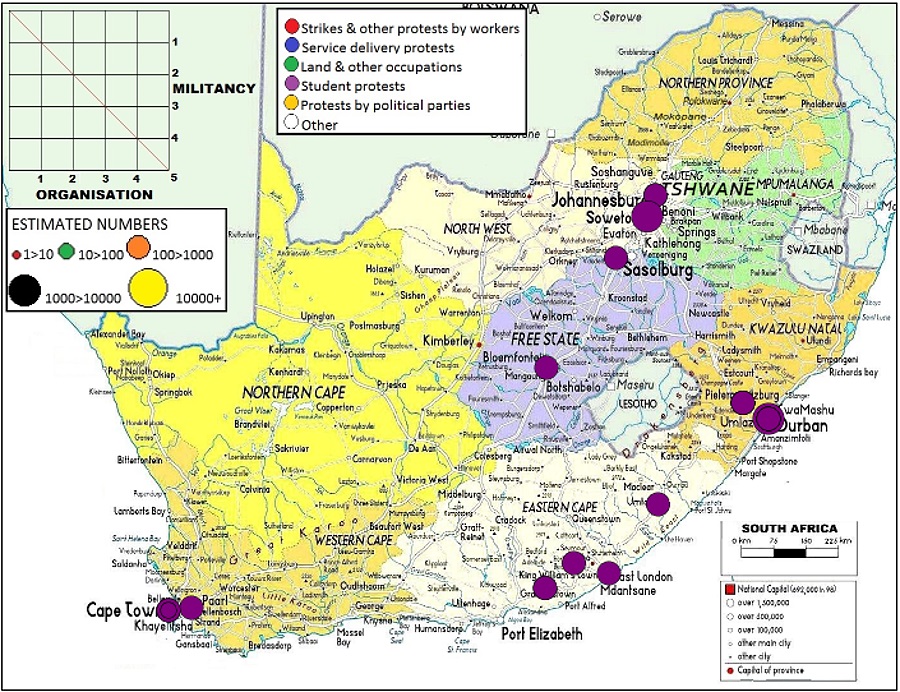 Student protests 2016 12 August: The Council on Higher Education concluded that a 0% fee increase would be unsustainable and recommended an inflation-related increase for South Africa’s universities in 2017. 14 August: Calls were made on social media for students to shut down universities on 15 August. These purportedly came from the South African Union of Students. Later in the day Minister for Higher Education, Blade Nzimande called for calm stating that no decision had (yet) been reached about fees. Meanwhile, ANC secretary general Gwede Mantashe reaffirmed the National Executive Committee's prevailing policy of no fee increases at South African universities. 15 August: Protests at the University of KwaZulu-Natal and Mangosuthu University of Technology over the purported fee increases lead to the suspension of the academic programmes at those universities. Police were deployed to some other universities in anticipation of protests. Blade Nzimande reiterated that no decision had been reached over fees for 2017. 20 August: Protests broke out at Walter Sisulu University's iBika campus in Butterworth and Nelson Mandela Drive campus in Mthatha. Hundreds of students blocked the N2 in both towns and are reported to have thrown stones at vehicles. Police in Mthatha responded with teargas and several students were arrested in Butterworth. South African president Jacob Zuma instructs Finance Minister Pravin Gordhan to "find the money" to ensure a 0% increase in 2017. This came despite National Treasury's warning that this was unaffordable and Nzimande's earlier position that universities needed at least a 6% increase to avoid “collapse”. The students conducted a feasibility study with an independent source and it was found that R60 Billion was lost in corruption annually and that free education at the same standard as it is paid (facilities, lectures etc.) would only cost R45 Billion annually. 25 August: Pravin Gordhan is reported as saying that if corruption could be addressed, South Africa could afford to cover university fees for students from poor backgrounds. This came shortly after outgoing rector of the University of the Free State, Jonathan Jansen told a press conference that he believed that there was no hope for South African universities. 19 September: The University of Cape Town suspended its academic project in anticipation of an announcement on the fees situation by Minister Nzimande. At 11AM Blade Nzimande announced that university fees would increase in 2017, but increases would be capped at 8%. He emphasized that university councils would make the final decisions about fees. However he went on to say that the government was still engaging with stakeholders to come up with a way to provide financial assistance to students with annual family incomes of below R600,000. As an immediate response, students at the University of Witwatersrand mobilised to shut down their campus, blockading entrances. The protesters claimed that all protest would be peaceful however they turned to violence when denied entrance to the Great Hall. Concrete objects were destroyed and pieces were thrown at security guards who were defending the Hall. The students were demanding "free decolonized education for black people". This was purportedly followed by students at University of the Free State and University of Pretoria. October On the 10th October Students at the University Of Witwatersrand gathered at the Great Hall, an area on the campus. The students were denied access to the hall by private security. They were soon replaced by the South African Police Force. The police, in order to disperse the protesters fired rubber bullets, stun grenades and smoke grenades. 2 students were injured and 11 were arrested by police (recorded at approximately 11:00). By the afternoon the students started throwing rocks. One bus was alleged to be, but no proof was found,burnt by students. Students at the University of Pretoria however picked up rocks and put them in bins to show a sign of peace. On the 25th October vehicles were set on fire by protesters at the University of Cape Town. https://en.wikipedia.org/wiki/FeesMustFall |
 ACLED (Armed Conflict Location & Event Data Project) is the most comprehensive public collection of political violence and protest data for developing states. This data and analysis project produces information on the specific dates and locations of political violence and protest, the types of event, the groups involved, fatalities, and changes in territorial control. Information is recorded on the battles, killings, riots, and recruitment activities of rebels, governments, militias, armed groups, protesters and civilians. Data can be downloaded on the Data page, trend reports, working papers and other analysis from our Publications page, updated analysis on ongoing crises is found at our Crisis Blog. As of early 2016, ACLED has recorded over 100,000 individual events, with ongoing data collection focused on Africa and ten countries in South and Southeast Asia. The data can be used for medium- and long-term analysis and mapping of political violence across developing countries through use of historical data from 1997, as well as informing humanitarian and development work in crisis and conflict-affected contexts through realtime data updates and reports. ACLED data show that political violence rates have remained relatively stable in the past seventeen years, despite the waning of civil wars across the developing world. ACLED seeks to support research and work devoted to understanding, predicting and reducing levels of political violence. ACLED MAPS ACLED map superimposed on hi res map additinal info on incidents can be added later  The EJ Atlas is a teaching, networking and advocacy resource. Strategists, activist organizers, scholars, and teachers will find many uses for the database, as well as citizens wanting to learn more about the often invisible conflicts taking place.
2 Hydraulic fracking in the Karoo, South Africa 3 Pondoland Wild Coast Xolobeni mining threat, South Africa 4 Bisasar Rd Landfill Site, South Africa 5 Mtunzini - Exxaro proposed sand mining, South Africa 6 Richards Bay Minerals dune mining, South Africa 7 Chiawelo, Soweto, electricity struggles, South Africa |
| MORE INFORMATION BY PROVINCE |
LINKS FOR MORE INFORMATION ON PROTEST IN SOUTH AFRICA EJOLT (Environmental Justice Organisations, Liabilities and Trade) ACLED (Armed Conflict Location and Event Data Project) The GDELT Project Project Gauteng City-Region Observatory (GCRO) |
PROTEST MAPPING FOR SOUTH AFRICA
XXXXXXXXXXXXXXXXXXXXXXXXXXXXXXXXXXXXXXXXXXXXXXXXXXX
XXXXXXXXXXXXXXXXXXXXXXXXXXXXXXXXXXXXXXXXXXXXXXXXXXX
XXXXXXXXXXXXXXXXXXXXXXXXXXXXXXXXXXXXXXXXXXXXXXXXXXX
XXXXXXXXXXXXXXXXXXXXXXXXXXXXXXXXXXXXXXXXXXXXXXXXXXX
XXXXXXXXXXXXXXXXXXXXXXXXXXXXXXXXXXXXXXXXXXXXXXXXXXX
XXXXXXXXXXXXXXXXXXXXXXXXXXXXXXXXXXXXXXXXXXXXXXXXXXX
XXXXXXXXXXXXXXXXXXXXXXXXXXXXXXXXXXXXXXXXXXXXXXXXXXX
XXXXXXXXXXXXXXXXXXXXXXXXXXXXXXXXXXXXXXXXXXXXXXXXXXX
Back |
Make a free website with Yola
